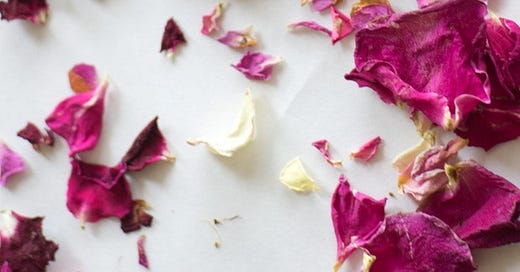Eating flowers is not new. And soon it will be rose season. Admire them, smell them, and cook them.
Photo Courtesy of 101 Cookbooks
My mother and I raised nasturtiums in our kitchen garden in Sydney in the 1950’s. Australian sandwiches then were bread, lots of butter, Nasturtium leaves, salt and pepper. It wasn’t until 1973 or so that I started to use their flowers in salads. The peppery bite against the sweetness of nut oils a perfect match. Then Richard Olney, at his house in the south of France, in his kitchen garden where we would drink Krug after harvesting handfuls of borage, sage, and arugula flowers. And talk about the balance of acid, sweet perfumes, and what salad greens demanded which flowers and oils. Soon, every morning on the way to the Chez Panisse kitchen I had my eyes open for any nasturtiums hanging over sidewalk walls. Or lavender and rosemary.
After selling my part of Panisse and heading up Berkeley’s Santa Fe Bar & Grill, flowers were scattered over several 1980’s menus. For the birthday of Gourmet magazine’s wine columnist, Gerald Asher, “Garden herbs, flowers & black truffle soup.” And for a Napa Valley Wine Symposium, “Poached wild striped bass with chervil and nasturtium sauces.”
What is new, is the rule of tweezers in placing flowers. I am of the school where a little careless scattering, carefully done, is a preferred method and result. As well as using petals only, not the flowers with the sepals still intact. I mean, who wants to chew down on those? Like eating chicken with the feathers still on.
The next time I am in Paris after smelling the roses at the Parc Bagatelle, I will head to the Rue des Rosiers in the Jewish neighborhood. To search out Les Editions de l’Epure and, specifically, the little book called La Rose.
These editions cover curry, goat cheese, truffles, oysters, potatoes and sardines. And figs, leeks and pigs as well as eggs, pumpkins and dates. There are more about beetroot, honey and monkfish. But La Rose: Dix facons de la preparer caught my eye.
Let’s face it, and the Preface does, roses are at once ephemeral and eternal, and if that was enough, they have “unctuous perfumes, suave and intense colors. And a flesh that is langoureuese [the English word does not have the same corruption as the French], an elegance, a secret.” With names like “Rendez-vous,” “Garland of Love,” and “Naked Thigh of a Nymph”, how can one resist eating them? After all, sometimes or even often, depending on the chef, French frogs legs are often called Cuisses des Nymphes or nymphs’ thighs, naked or not.
It was with some excitement that I thumbed through the pages of this little book to find its secrets, looking for a recipe for frog’s legs with rose petals. No such luck. I did find:
Asparagus with a sweet-sour sauce of roses
Scallops rolled in breadcrumbs mixed with crushed dried rose buds
A velouté soup of fresh little peas garnished with slivers of fresh rose petals
Foie gras in a sauce of rose vinegar, rose water, and fresh petals
Couscous served with vegetables perfumed with almond and rose oils
A terrine of lamb braised with rose buds
Boned quails stuffed with prunes, Sarawak pepper and pistachios and then grilled over dried rose branches
A Napoleon filled with a paste of pistachios, walnuts and dried roses
And a lost bread, pain perdu, or a French toast with crystallized rose petals.
No frogs.
However, I found solace in the last recipe, which is for freshly cooked warm, round, little donuts filled with rose petal jam.





